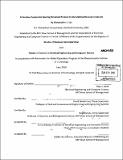A decision system for routing returned product to the optimal recovery channel
Author(s)
Lin, Christopher C. (Christopher Cheyih)
DownloadFull printable version (5.836Mb)
Other Contributors
Leaders for Global Operations Program.
Advisor
David Simchi-Levi and Roy Welsch.
Terms of use
Metadata
Show full item recordAbstract
Dell, a leading computer manufacturer, must deal with systems returned from its customers. Historically, it has refurbished most of its returned systems for resale on its Dell Outlet website. While this has provided high net recoveries (revenue less incurred costs) compared to its peers, Dell believes there is ample opportunity in cannibalizing some returned systems for the piece parts (i.e. "teardown"). These harvested piece parts can be used to service field systems, repair refurbished systems, or directly sold to customers as spare parts. Dell is concerned about ensuring an optimal disposition of system to teardown vs. direct resale. Written as part of research internship at Dell, this paper proposes, simulates, and evaluates a decision support system to address the question of disposition. The decision engines use historical data and statistics to estimate net recoveries in resale and forecasted demand to estimate net recoveries through teardown. Linear regressions were found to have poor power in predicting overall net recoveries; however, simple heuristics were found to identify likely low recovery systems. Overall, the implementation of the decision support system will drive improved net recoveries, with savings estimated to be greater than $1 million annually.
Description
Thesis (M.B.A.)--Massachusetts Institute of Technology, Sloan School of Management; and, (S.M.)--Massachusetts Institute of Technology, Dept. of Electrical Engineering and Computer Science; in conjunction with the Leaders for Manufacturing Program at MIT, 2010. Cataloged from PDF version of thesis. Includes bibliographical references (p. 62-63).
Date issued
2010Department
Leaders for Global Operations Program at MIT; Massachusetts Institute of Technology. Department of Electrical Engineering and Computer Science; Sloan School of ManagementPublisher
Massachusetts Institute of Technology
Keywords
Sloan School of Management., Electrical Engineering and Computer Science., Leaders for Global Operations Program.